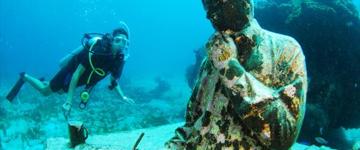Teotihuacan
Teotihuacan means 'The City of the Gods", or "Where Men Become Gods" (in Nahuatl).
It used to be a thriving city and ceremonial center that predated the Aztecs by several centuries. Most likely it was Mexico's biggest ancient city at its peak and the sixth largest city in the world in AD 600.
Teotihuacan began declining sharply around 650 AD, and was almost completely abandoned around 750 AD. No one knows why.
At its peak around 500-600 A.D., Teotihuacan contained perhaps 200,000 people. It was a well planned city covering nearly eight square miles and larger and more advanced than any European city of the time. Its civilization was contemporary with that of ancient Rome , and lasted longer - more than 500 years.
Though archaeologists have long been fascinated with the site, Teotihuacan's culture and history are still largely mysterious. The civilization left massive ruins, but no trace has yet been found of a writing system and very little is known for sure about its inhabitants, who were succeeded first by the Toltecs and then by the Aztecs.
The Aztecs did not live in the city, but gave the place and its major structures their current names. They considered it the "Place of the Gods" - a place where, they believed, the current world was created.
This ancient city is the most visited of Mexico’s archaeological sites and a must-see if you’re in Mexico City. The site is impressive for its scale, both in the size of the Pyramid of the Sun (the third largest pyramid in the world) and the majesty of the Calle de los Muertos (Street of the Dead) - originally 4km long and flanked by temples, palaces and platforms. Look for amazingly well preserved murals in the Palace of the Jaguars or the Palace of the Quetzal-butterfly and bold sculptures in the Temple of Quetzalcoatl.
Be prepared for lots of walking and climbing here, and remember that the altitude will make your exertions more tiring than usual. The Pyramid of the Sun is the tallest of the two major pyramids, though it is an easier climb than the Pyramid of the Moon which has larger steps. If at all possible, we’d recommend climbing to the top of the Sun and then at least to the first platform of the Moon for the awesome view down the Calle de los Muertos.
Bearing the above in mind, bring some water (the refreshment stalls are quite a distance from the pyramids) a sunhat, camera, guidebook - but little else to drag around. As usual it’s best to arrive early in the morning or towards the end of the day to avoid the crowds or the heat (morning is best in summer, when rainfall is more common in the afternoon). Most of the tour buses have an annoying habit of starting out early in the morning but then stopping at other less strenuous sights on the way, and/or calling in at a souvenir shop before the site, so that you finally arrive around noon. Note that in winter it can actually be quite cool (even if it is warm in the city), and a sweater is recommended.

